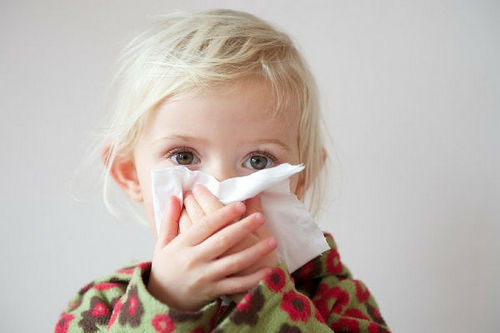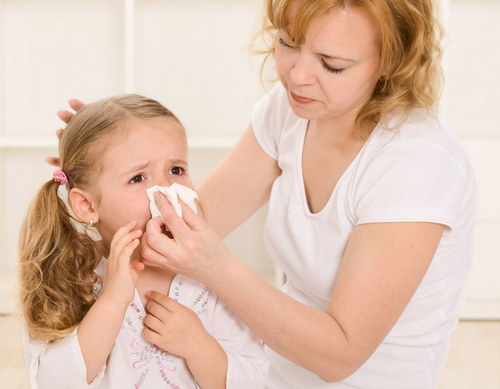Runny nose – an unpleasant symptom, but when you constantly stuffy nose, we are talking about a serious issuethat needs to be treated comprehensively. First we need to know the causes of constant runny nose and nasal congestion in adults and children.
A complication of inflammatory processes of the nasopharynx
Often do not pass a cold and prolonged nasal congestion be the result of suffering either goes untreated inflammatory diseases of the nose (acute rhinitis, otitis media, pharyngitis, and even sinusitis, rapidly spreading infection in the nose).
Anatomical disproportion of the nose
Various congenital defects of the nasal septum over time lead to hypertrophy of the shell nose. As a result, people are constantly coming snot or stuffy nose.
The presence of irritating factors
In some cases, the constant runny nose develops when frequent contact with hazardous substances. It may be industrial gases, heavy metals, dust, with which people often contact at work. The impact of hazardous substances on the nasal mucosa leads to inflammation, loss of cilia: as a result of the constantly stagnant mucus in the nose.

Poor circulation in the nasal mucosa
Certain chronic diseases lead to frequent and sometimes systematic violations of blood circulation. As a result, this problem comes to the nasal mucosa. Disruptions in blood circulation occur with high blood pressure, kidney diseases, frequent constipation, alcoholism, and irreversible processes that occur with the endocrine system.
Long-term use of pharmaceutical drugs
The problem of constant mucus in an adult can be an unpleasant consequence of frequent use of funds from nasal congestion. If you long to drip various drugs vasoconstrictor action, this may result in the occurrence of vasomotor rhinitis.
Allergy
Another adverse factor in provoking constant runny nose in adults and children, Its causes can be ascertained and eradicated upon detection of the allergen.
The types of constant runny nose
The concept of permanent rhinitis or chronic rhinitis involves irritated mucous membranes of the nose, his nasal, incessant snot, although sometimes it happens so that the nose constantly laid, but the cold itself is not.

There is a definite classification, according to which chronic rhinitis is:
- Catarrhal. Manifested in those cases where the cold just wasn’t dolecek. Remaining on the mucous membrane of destructive bacteria continue to affect it. In the result of malfunctions in the immune system. Symptoms of illness: severe headaches, problems with sense of smell and breathing, nasal congestion.
- Hypertrophic. Deviated septum causes the development of rhinitis in the chronic form. The disease began to manifest when grow strongly bone that form the nasal framework. Symptoms: restlessness, fatigue, impaired sense of smell.
- Atrophic. Occurs as a result of trauma or surgery. Symptoms: dry nose, crusting on the mucosa, loss of smell, bleeding from the nose.
- Vasomotor. Pathology occurs when violations of vascular tone (hypotension, endocrine diseases, etc.). Symptoms: stuffy nostrils (alternate). The smell is perfectly in order. For this reason, to diagnose the disease can only specialist.
How to cure adult runny nose and constant congestion?
The causes of the disease and its treatment are closely related, so it is very important to choose the appropriate treatment only after accurate diagnosis.
Medication
In the catarrhal type of cold, when the cause of rhinitis was caused by the infection usually used:
- The rate of corrective osteotomy for the correction of the condition of the body’s defense system;
- Special nose drops to cleanse the nasal (Izofra, Polideksa);
- A course of medicines to prevent spread and recurrence of infection.
In allergic rhinitis, there should be no contact of the patient with the stimulus. However, in cases where the deletion of the allergen is simply impossible (for example, a person allergic to dust or pollen), mandatory appointed antihistamines (loratadine, Aerius) and decongestants (Flixonase, Nasarel). Additionally, it may be applied to specific, but in some cases an effective method of immunotherapy, when introduced into the body in greater and greater amounts of the allergen.
In atrophic rhinitis prescribe a spray, drops and other means, the purpose of which is the food of the nasal mucosa. Additionally prescribed a course of vitamins, A, E, D, and preparations with content of iron.
In vasomotor rhinitis, the situation is exacerbated by the specificity of vascular diseases, which are also difficult to treat. In this case, the expert recommends to adjust the pace of life, avoid stress, do not forget about moderate exercise, take a contrast shower. Additionally appointed drops and sprays designed to treat a specific type of rhinitis (Nasonex, blockade with procaine, etc.).
When rhinitis caused by defects in the structure of the nasopharynx, it is possible to introduce in the problem area of hydrocortisone solution, moxibustion special acids (e.g., chrome) and so in the absence of the desired effect, the treatment is not without surgical intervention.
Speaking about all types of rhinitis, hypertrophic in addition to, not to mention a folk remedy for nasal congestion that will help to alleviate the course of the disease at an early stage:
- Beet drops. Product based on beet-carrot juice is a great homemade method of dealing with a constant runny nose. For the preparation of the mixture, grate the beet and carrot, squeeze through cheesecloth juice (or use a juicer), add a few drops of garlic juice and pour vegetable oil (the amount equivalent to the amount of juice). Drip no more than 2 times a day.
- Onion infusion. The best recipe for the treatment of rhinitis, the cause of which were bacteria. To prepare this infusion you will need one onion of medium size and 5 tablespoons of vegetable oil. In the pressed juice, add the oil, mix thoroughly and leave to infuse overnight. To drip into the nasal passages not more than 2-3 times a day.
- Honey inhalation. Helps to eliminate inflammation from the nasopharynx, will accelerate the cleansing of mucus. In a small bowl of hot water add 1 tablespoon of honey, shake to dissolve. Breathe over the steam for about 15 minutes every day.
- Saline solution. To use this tool only after consultation with a specialist. The recipe of the solution is very simple: 1 liter of warm boiled water 1 teaspoon of sea salt. Application solution: prepared by composition to collect in a special bag for washing and pour into one nostril (head tilted so that the solution got into the other nostril). The use of inefficient in the case of the presence of crusts in the nose.
Physiotherapy
Physical therapy chronic rhinitis involves a course of phototherapy (ultraviolet laser) and the application of UHF-therapy in the nose. When light treatment uses ultraviolet and bactericidal irradiators of various modifications. The purpose of their application is to resolve an acute manifestation of the main symptoms of the disease. Course duration – 2-3 days with a frequency of 1 times a day (preferably in the morning).
Laser therapy can be performed not only in outpatient but also at home. Warm up the nose area are used primarily laser devices with small emitter area of effect. The duration of the course is several days with a frequency of 7-10 procedures every day. The impact device must be done from both sides in the area of the nose wings (duration – not more than 5 minutes on each side).
Therapy using UHF-devices are assigned: in the acute form of rhinitis a short course with frequency of application not more than 3 times a day; with vasomotor 5-7 treatments daily.
Features of treatment of the constant runny nose in children
If the child has constant snot and throat irritation, it also indicates the presence of problems requiring immediate treatment. In the case where the runny nose is accompanied by a large amount of mucus, it is important as often as possible to free up the nasal passages.

Parents, it is important to know what to do if your child has snot constantly, as of late, and, especially, ignorant treatment may lead to inflammation of the throat, cough. Persistent runny nose and severe nasal congestion in a child require the use of vasoconstrictor drugs (but not more than 7 days to avoid a sense of addiction). We should not forget about moisturizing the nasal passages: be sure to use a saline solution, an oil-based composition of vitamins A and E (Pinosol, Evkalipt, vitamin solution).
If discharge from the nose have a green or yellow color, there is bacterial rhinitis: it is necessary to use antibiotics.
IMPORTANT. If the child is prone to frequent colds, it is desirable to use high-quality immunomodulators, medicines based on herbs.
Prolonged rhinitis is dangerous because in the absence of proper treatment or delayed its application it can have a negative impact on the body:
- reduced immunity, which can result in other diseases;
- insomnia;
- irritability;
- partial or complete loss of smell;
- sinusitis, tonsillitis, etc.;
- strep throat, meningitis, otitis media;
- abscesses of the brain or tonsils.
Prevention of problems
Prevention of disease is very simple.
The main thing is to follow the recommendations and take care of your body:
- Time to treat ENT diseases.
- Eat right by consuming mineral-rich foods.
- To monitor immune status and, if necessary, to improve it;
- To avoid stress, negative effects on the body and, in particular, the impact of aggressive factors on the nasopharynx.
Runny nose – the problem is not dangerous if in time to begin her fight. Most importantly, do it correctly.



